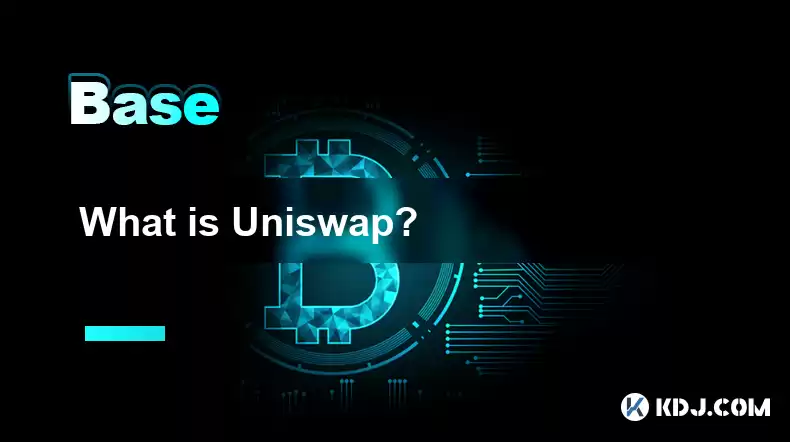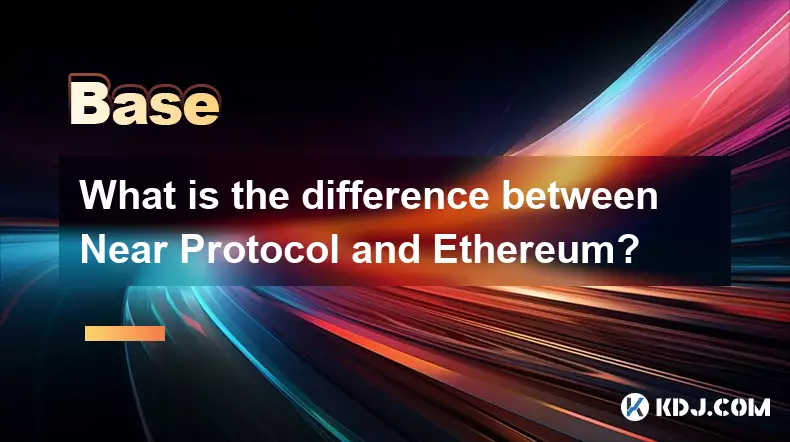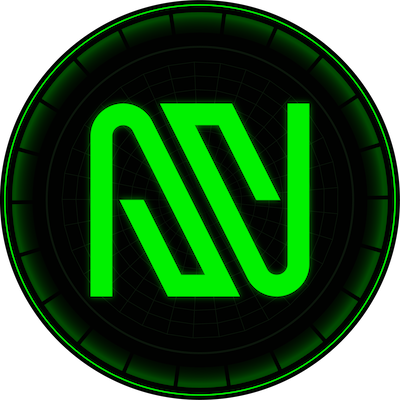-
 bitcoin
bitcoin $108842.957301 USD
-1.88% -
 ethereum
ethereum $3931.777121 USD
-1.66% -
 tether
tether $1.000186 USD
-0.03% -
 bnb
bnb $1153.250882 USD
-2.20% -
 xrp
xrp $2.367904 USD
-1.94% -
 solana
solana $186.182050 USD
-4.20% -
 usd-coin
usd-coin $0.999997 USD
0.00% -
 tron
tron $0.316949 USD
-1.00% -
 dogecoin
dogecoin $0.190780 USD
-3.12% -
 cardano
cardano $0.651324 USD
-2.67% -
 hyperliquid
hyperliquid $37.141055 USD
-0.85% -
 ethena-usde
ethena-usde $0.999224 USD
-0.09% -
 chainlink
chainlink $17.579031 USD
-2.47% -
 bitcoin-cash
bitcoin-cash $509.426284 USD
-2.79% -
 stellar
stellar $0.315298 USD
-2.93%
What is Uniswap?
Uniswap, a decentralized exchange built on Ethereum, empowers users with direct access to crypto assets trading and transparent governance through its native UNI token.
Feb 17, 2025 at 07:48 pm

- Uniswap is a decentralized exchange (DEX) built on the Ethereum blockchain.
- It operates on an automated market maker (AMM) model, providing liquidity pools of crypto assets for users to trade.
- Uniswap eliminates the need for a central authority or intermediaries, offering trustless and transparent transactions.
- UNI, the native token of Uniswap, is used for governance and incentivizing liquidity providers.
- The UNI token's recent surge in value has attracted attention to Uniswap's growing popularity.
Uniswap is a leading decentralized exchange (DEX) that has revolutionized the cryptocurrency trading landscape. It operates on a unique automated market maker (AMM) model, enabling users to trade assets directly from liquidity pools rather than through an order book.
How Uniswap's AMM Model Works:- Liquidity providers (LPs) deposit asset pairs into smart contract-based liquidity pools.
- When a trader makes an exchange, the AMM algorithm automatically adjusts the ratio of assets in the pool, ensuring continuous liquidity at a fair market price.
- LPs earn trading fees proportional to the liquidity they provide.
- Decentralization: Uniswap eliminates the need for a central authority, allowing users to trade directly, in a trustless and transparent manner.
- Lower Fees: Uniswap's AMM model offers significantly lower transaction fees compared to traditional exchanges.
- Accessibility: Uniswap is accessible to anyone with an Ethereum wallet, providing equal opportunity for participation in the crypto market.
- Diverse Asset Selection: Uniswap hosts a wide range of cryptocurrencies, including Ethereum, ERC-20 tokens, and even synthetic assets.
UNI is the native token of Uniswap, introduced through a governance model that gave early users and LPs a portion of the supply. UNI holders can:
- Participate in governance by voting on Uniswap's protocol development.
- Stake UNI to earn a portion of the trading fees generated by the platform.
- Use UNI to participate in new token offerings and liquidity mining programs.
The UNI token has experienced a significant increase in value in recent months, influenced by:
- Increased adoption of Uniswap as the preferred DEX for trading Ethereum-based assets.
- The growing demand for decentralized financial services (DeFi).
- Uniswap's innovative governance model and community ownership.
- What are the advantages of Uniswap over centralized exchanges?
- Decentralization, lower fees, accessibility, and diverse asset selection.
- How can I use Uniswap?
- You need an Ethereum wallet and cryptocurrencies to trade. Connect your wallet to Uniswap's website or mobile app and start trading.
- What is the future of Uniswap?
- Uniswap continues to evolve with new features and partnerships. The future holds further growth and integration with the DeFi ecosystem.
Disclaimer:info@kdj.com
The information provided is not trading advice. kdj.com does not assume any responsibility for any investments made based on the information provided in this article. Cryptocurrencies are highly volatile and it is highly recommended that you invest with caution after thorough research!
If you believe that the content used on this website infringes your copyright, please contact us immediately (info@kdj.com) and we will delete it promptly.
- Cardano, Dogecoin, and the Token Rally: What's the Hype?
- 2025-10-17 22:45:16
- Milk Mocha Meme Coin: Last Call for Whitelist & Early HUGS Gains!
- 2025-10-17 22:45:16
- Crypto's New Sweetheart: Milk & Mocha's $HUGS Token and the Early Rounds Advantage
- 2025-10-17 22:25:12
- Crypto Picks for 2025: Blazpay Presale and Emerging Trends
- 2025-10-17 22:50:12
- Meme Coins: Riding the Early Bird Gold Rush
- 2025-10-17 23:05:12
- Shannon Man, Cash Prizes, and Coin Games: A New York Minute on a Georgia Arrest
- 2025-10-17 22:50:12
Related knowledge

How do decentralized identity (DID) solutions work?
Oct 14,2025 at 11:36pm
Understanding Decentralized Identity in the Blockchain Ecosystem1. Decentralized identity (DID) solutions are built on blockchain networks, allowing i...

What is the difference between Near Protocol and Ethereum?
Oct 15,2025 at 08:01am
Near Protocol and Ethereum: Core Architectural Differences1. Near Protocol operates on a sharded blockchain architecture known as Nightshade, which al...

What does it mean for code to be "open source" in crypto?
Oct 12,2025 at 01:54pm
Understanding Open Source in the Cryptocurrency Ecosystem1. In the context of cryptocurrency, open source refers to software whose code is publicly ac...

What is the purpose of a "testnet"?
Oct 12,2025 at 09:01am
Understanding the Role of Testnets in Blockchain Development1. A testnet serves as a parallel version of a blockchain network, designed specifically f...

How to avoid phishing scams in crypto?
Oct 13,2025 at 06:18pm
Understanding Common Crypto Phishing Tactics1. Cybercriminals frequently use fake websites that mirror legitimate crypto exchanges or wallet platforms...

What is the difference between single-collateral and multi-collateral Dai?
Oct 12,2025 at 05:18pm
Understanding Single-Collateral Dai1. Single-Collateral Dai (SCD) was the original version of the Dai stablecoin launched by MakerDAO in 2017. It allo...

How do decentralized identity (DID) solutions work?
Oct 14,2025 at 11:36pm
Understanding Decentralized Identity in the Blockchain Ecosystem1. Decentralized identity (DID) solutions are built on blockchain networks, allowing i...

What is the difference between Near Protocol and Ethereum?
Oct 15,2025 at 08:01am
Near Protocol and Ethereum: Core Architectural Differences1. Near Protocol operates on a sharded blockchain architecture known as Nightshade, which al...

What does it mean for code to be "open source" in crypto?
Oct 12,2025 at 01:54pm
Understanding Open Source in the Cryptocurrency Ecosystem1. In the context of cryptocurrency, open source refers to software whose code is publicly ac...

What is the purpose of a "testnet"?
Oct 12,2025 at 09:01am
Understanding the Role of Testnets in Blockchain Development1. A testnet serves as a parallel version of a blockchain network, designed specifically f...

How to avoid phishing scams in crypto?
Oct 13,2025 at 06:18pm
Understanding Common Crypto Phishing Tactics1. Cybercriminals frequently use fake websites that mirror legitimate crypto exchanges or wallet platforms...

What is the difference between single-collateral and multi-collateral Dai?
Oct 12,2025 at 05:18pm
Understanding Single-Collateral Dai1. Single-Collateral Dai (SCD) was the original version of the Dai stablecoin launched by MakerDAO in 2017. It allo...
See all articles










































































